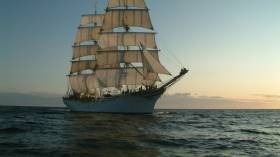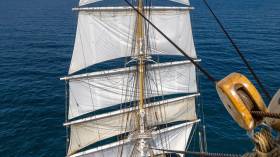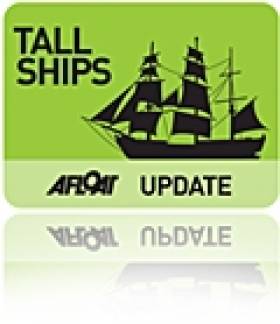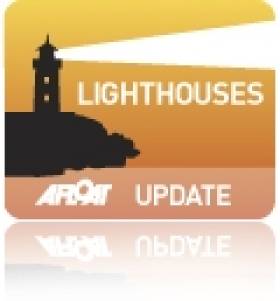Displaying items by tag: Heritage Week
Heritage Week Includes Islands to Entice
As part of Heritage Week (17-25 August) the programme includes a selection of lovely islands and a wide range of activities to entice you.
From waltzing on Scattery Island, Co Clare or learning about boatbuilding on Bere Island there are a multitude of events taking place over the week.
Here are the main events that are directly linked to islands. Note that some events are totally free; in others ferry trips must be paid.
Where events are during part of the day, the times are given, otherwise events take place over a full day.
So to check out details from the islands listed the Irish Examiner has more here
#HeritageWeek – As part of Heritage Week events, Norwegian tallship, Statsraad Lehmkuhl will be open today, Saturday, 20 August at Sir John Rogerson’s Quay, Dublin, with 'shanty' singing sailors between 2 and 4pm. No booking required nor admission fee.
In addition to the nautical theme, an exhibition to capture the history of Dublin Docks and surrounding dockland communities for the period 1960 to 1973, is to be held in Dublin next week.
The exhibition will feature photographs, memorabilia and copies of the Waterfront News, which was a unique publication/newspaper, that not only captured what was going on in Dublin Docks and the dockland communities but gave a flavour of what was going on in Irish society at that time.
The exhibition organised by Dublin Dock Workers Preservation Society will be held at Dublin City Council Civic Offices on Wood Quay.
Opening dates are from Monday 22 to Friday 26 August, and times are between 09.00 – 17.00. No booking is required nor admission fee.
Further exhibition details:
Suitable for Children: No
Wheelchair Access: Full
Car parking Available: No
Indoor/Outdoor: Indoor
Organiser Details website: www.bluemelon.com/alanmartin
Norwegian Tallship Open to Visitors During Heritage Week
#HeritageVisitor - A Norwegian tall ship, Statsraad Lehmkuhl is calling to Dublin Port as part of Heritage Week, and will be open for visitors.
Statsraad Lehmkuhl will be docked at Sir John Rogerson’s Quay, where on Saturday 20 August, one of the world’s biggest tallships will be open to the public between 2 and 4pm. No booking is required nor no fee to gain admission on board what is also one of the oldest of the world’s square rigger ships.
Due to extensive conservation work over the last few decades, the Statsraad Lehmkuhl still looks almost as it did when it was completely new more than a hundred years ago, and a visit on the ship is therefore like taking a step back in time.
Statsraad Lehmkuhl will sail to Dublin from A Coruña, northern Spain where it recently became the winner of Tall Ship Races 2016. The ship will depart Dublin on Sunday 21. August and sail back home to Bergen, Norway, a journey that will take five days.
Statsraad Lehmkuhl was built in 1914, in Bremerhaven-Geestemünde in Germany, as a training ship for the German merchant marine.
In 1923, the ship was bought by “Det Bergenske Damskipsselskap” (Bergen Steamship Company), and renamed “Statsraad Lehmkuhl” (Minister Lemhkuhl) after the man responsible for securing it.
Statsraad Lehmkuhl was used as a training vessel for Bergen School Ship Foundation until 1967, except for a brief interval during World War II when it was confiscated by Germany.
Later on, the ship was donated to the Statsraad Lehmkuhl Foundation, which is the current owner and operator of the ship.
Over the years, the Foundation has arranged cruises and coastal trips that are open for the public to attend. In addition, Statsraad Lehmkuhl has often been rented out to schools, companies, clubs and organisations that have used the ship for shorter trips.
In recent years, Statsraad Lehmkuhl has become a familiar sight in the Bergen harbour, blending in seamlessly with the colourful wooden houses at “Bryggen”.
Murphy Takes Asgard Centenary Talk To Fingal For Heritage Week
#Asgard - Boating historian and round-the-world yachtsman Pat Murphy will once again give his centenary talk on the famous gun-running ship Asgard and its pivotal place in Irish history over the coming days for 2014's Heritage Week.
The series of free talks in north coastal Dublin begins tomorrow (Monday 25 August) at the public library in Rush, moving to Donabate/Portrane (Tuesday 26), Malahide (Wednesday 27) and Baldoyle (Thursday 28).
Each evening's presentation begins at 6.30pm and booking ahead is essential – contact Charlie Quinn at Fingal County Libraries at [email protected] or call 01 8708464 or 01 8708414.
Mutton Island Lighthouse To Shine Once More
The refurbished Mutton Island lighthouse in Galway Bay will open to tour groups on a regular basis next year, the Galway City Tribune reports.
Once one of the final landmarks of the city seen by emigrants leaving on the 'coffin ships' bound for the United States in the Great Famine, its light last shone in 1977.
The protected lighthouse and its island were purchased by Galway City Council for a total of £2, and since then the 18th-century building fell into disrepair - although the island thrived as a sanctuary for artic terns and Claddagh swans.
But in 2005 a project was intitiated by Galway City Council and the Galway Civic Trust, involving FÁS trainees to restore the lighthouse and its grounds to their former glory, and the fruits of this labour are set to be unveiled next spring.
Recent free tours of the building for Hertiage Week were hugely popular, providing high hopes for the lighthouse and its gardens to become a valuable new amenity for the City of the Tribes.
The Galway City Tribune has more on the story HERE.
Heritage Week: Maritime Lectures In Dun Laoghaire
12.30 – 1.30 pm. Neutral Ireland's Role in the Sinking of the Bismarck, May, 1941 By Dr. Michael Kennedy, Executive Editor, Documents on Irish Foreign Policy, Royal Irish Academy.
1.30 – 2.30 pm. Traditional Boats of Ireland. - Wooden workboats from all the Maritime Counties of Ireland. By Darina Tully, Lecturer and Maritime Archaeologist.
2.30 – 3.30 pm. Too Many Bags in the Lifeboat. A Lifeboat Tragedy at Bray 1876 By James Scannell, Lecturer and P.R.O of the Old Dublin Society.
4.00 – 5.00 pm. Maritime Guinness, The Ships, Yachts and Barges of the Guinness Dynasty. By Dr. Edward Bourke, Diver, Maritime Historian and Author of "Guinness, the Family, the Business and the Black Stuff"
5.00 – 6.00 pm. Ireland's Armada Heritage. The Story of the Spanish Armada of 1588. The discoveries of the wrecks on the Irish Coast and the recovery of artifacts. By Cormac Lowth, Lecturer, Author and Diver.
Further information Barney Yourell 087 900 7466 No seminar charge – donations accepted. Information in general on the Maritime Institute of Ireland can be found on http://www.mariner.ieand for other nationwide events of the Heritage Week visit www.heritageweek.ie
- Events
- Dun Laoghaire Harbour
- M.I.I.
- Dun Laoghaire Harbour News
- Event news
- National Heritage Week
- Heritage Week
- Maritime Lecture Seminar
- Spanish Armada
- Eblana Centre Dun Laoghaire
- Maritime Insitute of Ireland
- Bismarck
- Traditional Irish wooden boats
- Guiness ships
- Guinness barges
- Darina Tully
- Irish heritage boats
Lecture: Dublin’s Own Titanic-The 'Tayleur'
The venue and is the Dún Laoghaire College of Further Education on Cumberland Street where a lecture series programme is run by the Genealogical Society of Ireland (GSI). For further information on other forthcoming GSI lectures: www.familyhistory.ie/
Heritage Week: Maritime Lecture Seminar Day
Below is listing of the lecture programme and times.
12.30 – 1.30 pm. Neutral Ireland's Role in the Sinking of the Bismark, May, 1941. By Dr. Michael Kennedy, Executive Editor, Documents on Irish Foreign Policy, Royal Irish Academy.
1.30 – 2.30 pm. Traditional Boats of Ireland. - Wooden workboats from all the Maritime Counties of Ireland. By Darina Tully, Lecturer and Maritime Archaeologist.
2.30 – 3.30 pm. Too Many Bags in the Lifeboat. A Lifeboat Tragedy at Bray 1876. By James Scannell, Lecturer and P.R.O of the Old Dublin Society.
3.30 – 4.00pm. Model Boats, A short talk to accompany the exhibition. By Garry Mooney secretary of the Irish Model Boat Club.
4.00 – 5.00 pm. Maritime Guinness, The Ships, Yachts and Barges of the Guinness Dynasty. By Dr. Edward Bourke, Diver, Maritime Historian and Author of "Guinness, the Family, the Business and the Black Stuff"
5.00 – 6.00 pm. Ireland's Armada Heritage. The Story of the Spanish Armada of 1588.The discoveries of the wrecks on the Irish Coast and the recovery of artifacts. By Cormac Lowth, Lecturer, Author and Diver.
For further information contact Barney Yourell Mob: 087 900 7466 No seminar charge – donations accepted
Information in general on the Maritime Institute of Ireland can be found on www.mariner.ie and for all the other events held during the National Heritage Week go to www.heritageweek.ie/
- Dublin Bay News
- Maritime Institute of Ireland
- Irish Model Boat Club
- Dun Laoghaire Club
- Dun Laoghaire Harbour
- M.I.I.
- Dun Laoghaire News
- RNLI Lifeboats
- National Heritage Week
- Heritage Week
- Maritime Lecture Seminar
- Sinking of the Bismark
- Traditional Wooden Irish Boats
- Guinness Ships
- Model Boats
- Ireland's Armada Heritage
- Spanish Armada
- Dun Laoghaire Maritime Museum





































































